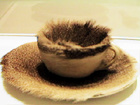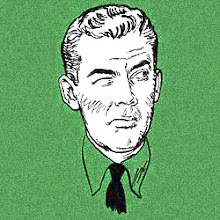 This untitled piece is one of Toyen's double-side collages (paper size 12¼" x 8¼"). This one is dated 1960 and is at the Gallery of Surrealism, 160 Bleecker Street. It was exhibited at Gallery de la Ville de Prague, May 12-August 6, 2000.
This untitled piece is one of Toyen's double-side collages (paper size 12¼" x 8¼"). This one is dated 1960 and is at the Gallery of Surrealism, 160 Bleecker Street. It was exhibited at Gallery de la Ville de Prague, May 12-August 6, 2000. Toyen was Marie Cerminova (1902 - 1980). Toyen never exhibited the double-sided collages she produced during the 1960s and 1970s and she probably did not even show them to any of her close friends. They were not made public until an auction in 1982.
Toyen, who rejected her name and chose to pursue her career as an artist under an assumed name, was the leading Czech surrealist and one of the many women who played important roles in the International Surrealist movement. A feminist, she rejected suggestions that she play a woman's role, and soon she endorsed the anarchist movement. She and the Czech poet, Jindrich Styrsky, went to Paris in the early 1920s and announced their own alternative to Abstraction and Surrealism, "Artificialism." By the mid-1930s, however, her work had become sufficiently Surrealist that, back in Prague, they became founding members of the Czech Surrealist group. In 1935, Andre Breton and Paul Eluard came to Prague and began a lifelong friendship with Toyen, interrupted only by the Nazi invasion and conquest of Czechoslovakia.


 Is '60 the moment when the end of the end of the Old Left had been reached and the New Left began to emerge? Is it the final ascendancy, in certain scenes at least, of poetic postmodernity? Surely the publication of Donald Allen's The New American Poetry that year suggests this, but then again--once again--we look back on "New" here and see continuity. The rhetoric of the Kennedy-Nixon contest made much less of a dent than everyone (at the time as well as since) claimed, so one wonders why were such great claims made?
Is '60 the moment when the end of the end of the Old Left had been reached and the New Left began to emerge? Is it the final ascendancy, in certain scenes at least, of poetic postmodernity? Surely the publication of Donald Allen's The New American Poetry that year suggests this, but then again--once again--we look back on "New" here and see continuity. The rhetoric of the Kennedy-Nixon contest made much less of a dent than everyone (at the time as well as since) claimed, so one wonders why were such great claims made?  Had we come to expect "1960" to be truly ubiquitously modern in a way that the 1950s really were not--not quite? And what specifically does "modern" mean in the Kennedyesque talk then and now about the torch being passed to a new generation, etc.? The First Lady really meant "modernist" when Camelotians said "modern." What about the others across the new young cultural leadership? I've been surprised by how frequently the
Had we come to expect "1960" to be truly ubiquitously modern in a way that the 1950s really were not--not quite? And what specifically does "modern" mean in the Kennedyesque talk then and now about the torch being passed to a new generation, etc.? The First Lady really meant "modernist" when Camelotians said "modern." What about the others across the new young cultural leadership? I've been surprised by how frequently the  "Beat movement" was covered in 1960 in the mainstream press. I was expecting a fair measure but I've found tonnage. 1960 was the year when the figure of the beat was beginning to find acceptance, although still 80% of these stories are mocking, rebels-without-cause condescension. For anyone whose analysis made an impact nationally, do these antipolitical adolescents count as part of the "new young cultural leadership"? No, but rather than the two being opposites, they fall along a Continuum of the New American. Now that's a change for '60.
"Beat movement" was covered in 1960 in the mainstream press. I was expecting a fair measure but I've found tonnage. 1960 was the year when the figure of the beat was beginning to find acceptance, although still 80% of these stories are mocking, rebels-without-cause condescension. For anyone whose analysis made an impact nationally, do these antipolitical adolescents count as part of the "new young cultural leadership"? No, but rather than the two being opposites, they fall along a Continuum of the New American. Now that's a change for '60.







